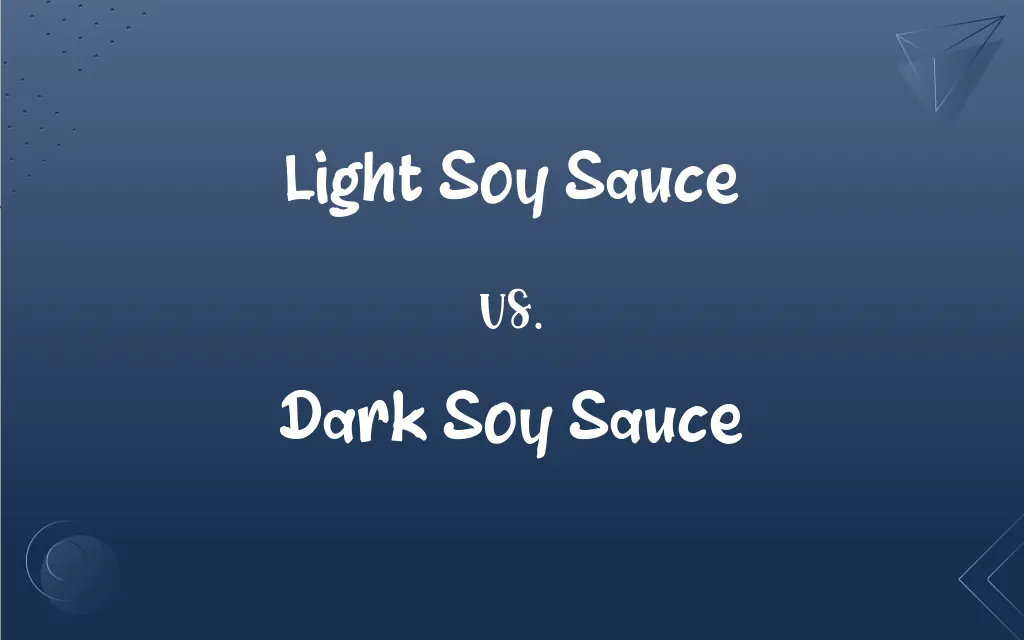Light Soy Sauce vs. Dark Soy Sauce: What's the Difference?
Edited by Janet White || By Harlon Moss || Updated on October 20, 2023
Light soy sauce is thinner and saltier, primarily used for seasoning, while dark soy sauce is thicker, sweeter, and used for coloring and rich flavors.

Key Differences
Light soy sauce, as its name implies, has a lighter color and is more fluid in consistency. In contrast, dark soy sauce is thicker and has a deep, rich hue that can dominate the dish it's added to.
The primary use of light soy sauce is for seasoning, adding a sharp, salty taste to dishes. Dark soy sauce, on the other hand, is often used for its coloring properties, giving dishes a deep brown color, and its slightly sweet, rich flavor.
When tasting them side by side, one might notice that light soy sauce has a more pronounced saltiness. Dark soy sauce, while still salty, has undertones of sweetness and a more complex flavor profile due to the longer fermentation and sometimes the addition of caramel or molasses.
Both light soy sauce and dark soy sauce are staples in various Asian cuisines. While they originate from the same primary ingredient, soybeans, the processes, and additives used make them distinct in their culinary applications and taste profiles.
Comparison Chart
Color
Lighter brown
Deeper, richer brown
ADVERTISEMENT
Consistency
Thinner
Thicker
Flavor
Saltier
Saltiness with sweet undertones
Primary Use
Seasoning
Coloring dishes and adding rich flavors
Ingredients & Additives
Mainly soybeans, wheat, salt, and water
Soybeans, wheat, salt, water, often with caramel or molasses
Light Soy Sauce and Dark Soy Sauce Definitions
Light Soy Sauce
Light soy sauce is primarily used for seasoning dishes.
To give the soup a hint of salt, he stirred in a bit of light soy sauce.
ADVERTISEMENT
Dark Soy Sauce
Dark soy sauce is a thicker, slightly sweet soy sauce with a rich hue.
He added a splash of dark soy sauce to give the stew a deeper color.
Light Soy Sauce
Light soy sauce is a staple in many Asian recipes for enhancing flavor.
Before serving the sushi, he provided a small dish of light soy sauce for dipping.
Dark Soy Sauce
Dark soy sauce has a longer fermentation process, resulting in a richer taste.
The complex flavors of the dark soy sauce were evident in the marinade.
Light Soy Sauce
Light soy sauce is a thinner, salty condiment derived from soybeans.
She splashed some light soy sauce into the stir fry for added saltiness.
Dark Soy Sauce
Dark soy sauce is primarily utilized for its coloring properties in dishes.
Wanting to darken the sauce, he poured in some dark soy sauce.
Light Soy Sauce
Light soy sauce has a light brown hue and is more fluid.
She noticed the light soy sauce dripping quickly off the spoon due to its thin consistency.
Dark Soy Sauce
Dark soy sauce often contains caramel or molasses, enhancing its flavor and color.
She could taste the subtle sweetness in the dark soy sauce, hinting at added molasses.
Light Soy Sauce
Light soy sauce often tastes saltier than its dark counterpart.
For a less intense salt flavor, she decided to use less light soy sauce.
Dark Soy Sauce
Dark soy sauce is essential in several Asian dishes for its distinctive flavor and appearance.
To make the dish authentic, she made sure to use dark soy sauce.
FAQs
What is the primary ingredient for both light soy sauce and dark soy sauce?
Both light soy sauce and dark soy sauce are made from fermented soybeans.
How should I store both light soy sauce and dark soy sauce?
Both should be stored in a cool, dark place and can be refrigerated after opening to extend shelf life.
Do both light soy sauce and dark soy sauce come from the same fermentation process?
While both are products of fermentation, dark soy sauce often undergoes a longer fermentation process.
Why might a dish turn out darker than expected when using soy sauce?
Using dark soy sauce can result in a deeper color due to its rich hue and potential caramel or molasses content.
Which soy sauce would you recommend for a dipping sauce?
Light soy sauce is often preferred for dipping sauces due to its pronounced saltiness, but personal preference matters.
Are there gluten-free versions of both light soy sauce and dark soy sauce?
Yes, gluten-free versions are available since traditional soy sauce contains wheat. Always check the label.
Is light soy sauce used more for flavor or color in dishes?
Light soy sauce is primarily used for flavor, especially its salty taste.
What gives dark soy sauce its deeper color?
Dark soy sauce gets its rich color from a longer fermentation process and often the addition of caramel or molasses.
Can you substitute light soy sauce for dark soy sauce in recipes?
While they can be substituted for each other, it will affect the dish's flavor and color, so adjustments may be needed.
Are there specific dishes that call only for dark soy sauce?
Yes, certain dishes, especially in Asian cuisine, specifically call for dark soy sauce for its color and flavor.
Are there health differences between light soy sauce and dark soy sauce?
Both types contain sodium, but specific health differences would depend on the brand and any added ingredients.
Why might someone choose dark soy sauce over light soy sauce in a recipe?
They might choose dark soy sauce for its richer flavor, sweet undertones, and color-enhancing properties.
Can I mix light soy sauce and dark soy sauce in a dish?
Absolutely, many recipes combine both to balance flavor and achieve the desired color.
Does dark soy sauce contain more additives than light soy sauce?
Dark soy sauce often has added caramel or molasses, which aren't typically found in light soy sauce.
Can I reduce the saltiness of a dish if I used too much light soy sauce?
Yes, you can try balancing it with other flavors or diluting the dish, but it's best to add light soy sauce gradually.
How does the consistency differ between light soy sauce and dark soy sauce?
Light soy sauce has a thinner consistency, while dark soy sauce is thicker.
Which type of soy sauce is typically saltier?
Light soy sauce typically tastes saltier than dark soy sauce.
Is light soy sauce always light in color?
Light soy sauce has a lighter brown hue compared to dark soy sauce, but it's not pale.
Which soy sauce is more common in sushi restaurants?
Light soy sauce is more commonly provided for sushi due to its salty, sharp flavor.
How does the flavor of dark soy sauce differ from light soy sauce?
Dark soy sauce has a richer, slightly sweet flavor, whereas light soy sauce is mainly salty.
About Author
Written by
Harlon MossHarlon is a seasoned quality moderator and accomplished content writer for Difference Wiki. An alumnus of the prestigious University of California, he earned his degree in Computer Science. Leveraging his academic background, Harlon brings a meticulous and informed perspective to his work, ensuring content accuracy and excellence.
Edited by
Janet WhiteJanet White has been an esteemed writer and blogger for Difference Wiki. Holding a Master's degree in Science and Medical Journalism from the prestigious Boston University, she has consistently demonstrated her expertise and passion for her field. When she's not immersed in her work, Janet relishes her time exercising, delving into a good book, and cherishing moments with friends and family.
































































